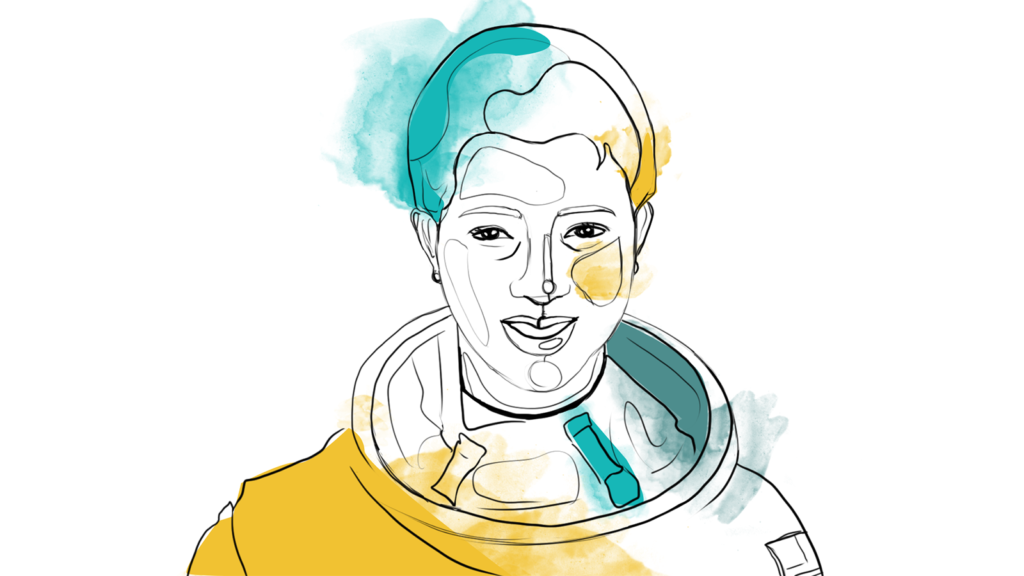Mae Jemison is the first African American woman to orbit the earth. She knew that she wanted to be a scientist since kindergarten. Not only did she grow up reading books about space, but she also loved science fiction books where black women were the heroes of the story.
At 16, Jemison graduated from high school and studied chemical engineering and African studies at Stanford University. Eventually, she became a doctor and traveled the world to care for patients. However, Jemison always held on to her love for space and space travel. So when NASA opened a new search for astronauts in 1987, she seized the opportunity and was accepted into the program.
In 1992, Jemison stepped foot on the space shuttle Endeavor as the science mission specialist, a new role for NASA that focused on conducting experiments in space. In seven days on the Endeavor, Jemison and her team conducted 44 experiments on motion sickness and weightlessness.
She stayed with NASA for six years before turning her sights on business, education, and writing. Let’s learn from the way she approached challenges and navigated the world.
This article is part of the Brilliant Thinkers series, which explores the thought processes, working habits, and decision-making principles applied by intellectuals who profoundly impacted the world with their discoveries and the way they challenged the status quo.
Mae Jemison’s thinking strategies
It takes all types of unique thinking strategies to become the first Black female astronaut in American history. Here are three of those strategies and how we can apply them in our lives and work.
1. Learning from everywhere. Aside from her studies, Jemison learned by doing many activities growing up. She was a part of student government, acted in school plays, and studied dance. She choreographed a performing arts piece called Out of the Shadows in college, which brought attention to the African American experience. She knew the value of learning from everywhere and anywhere, and her experiences in the arts and government taught her how to be graceful and the value of hard work.
2. Becoming a multi-hyphenate. Doctor, astronaut, entrepreneur, writer, teacher, and artist — all of these words describe Jemison and her phenomenal career. Before joining NASA, Dr. Jemison cared for patients in Cuba and a Taiwanese refugee camp. She joined the Peace Corps in 1983 and served as a medical officer in Liberia and Sierra Leone.
After her career as an astronaut, Jemison taught at Dartmouth College and ran the newly founded Jemison Institute for Advancing Tech in Developing Countries. She also founded the Dorothy Jemison Foundation for Excellence, which supports several programs, including a space camp and the 100 Year Starship program. Jemison even found time to write a book about her life, published in 2001. She was a true multi-hyphenate.
3. Opening new doors. Jemison was bothered that there were no women astronauts when she was growing up. She also experienced racial discrimination in her schooling and her career. Therefore, Jemison created opportunities for youth of color to become a part of the scientific community. For instance, the Earth We Share- Space Race program bolsters science education for teens in Los Angeles, CA. Her memoir, Find Where the Wind Goes, is also aimed at teens to inspire their journeys into science.
How to think like Mae Jemison
Jemison’s experiences as a performer and choreographer helped her develop hard and soft skills that she used throughout her career. Research shows that participating in the arts can help us with emotional regulation and reduce feelings of isolation. If arts are not a part of your life, try picking up a new craft, pulling out your old guitar, or playing around with your kids’ paints. As Jemison has demonstrated, engaging in creative expression can teach us valuable lessons for our careers and personal growth.
Another way to think like Mae Jemison is to “multi-hyphenate” yourself. Odds are, you are already a multi-hyphenate. Consider the different tasks that you do daily in your work life. Identify your descriptors and share those “hyphens” with your personal and professional network. Your unique skill set could open doors to new professional experiences.
Next, ask yourself: any other skills that you would like to explore? What are some adjacent areas that may not be obvious but will make your skill set more useful and valuable?
Finally, use your skills and your network to be an agent of change. Jemison used her influence to remove barriers and create opportunities for disadvantaged youth interested in sciences. What challenges have you faced in your education, employment, or personal life that you would be willing to share with others? How can you use those experiences to lower barriers for others who may face similar challenges? Brainstorm ways you can contribute to changing the status quo.
Mae Jemison’s unique and influential career as a doctor, astronaut, entrepreneur, and artist serves as inspiration for anyone who wants to do it all. To follow her lead, try your hand at something new, embrace all the things that make you who you are, and figure out ways to support future generations.

